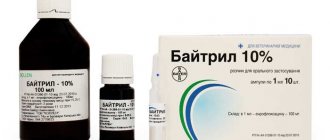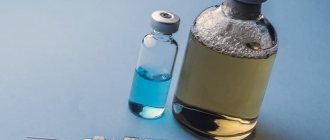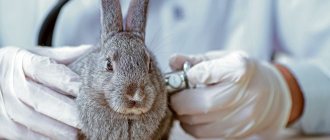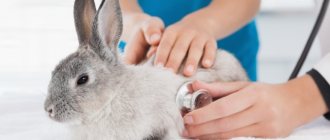Diseases
9609
1 comment
Baytril is an antibiotic, the active substance enrofloxacin from the group of fluoroquinolones, produced in the form of solutions in different concentrations. Baytril for rabbits – inhibits the growth of pasteurella, bacteria and mycoplasmas that accompany coccidiosis and pododermatitis. The developer is not considering Baytril for the treatment of rabbits. We need to do an analysis and, if possible, expand the list of animals that can use this antibiotic.
Photo. Baytril instructions for use at 10% concentration
Baytril, instructions for rabbits
Baytril is an antibiotic that is produced in Russia using technology from the German concern Bayer. In our country, one dosage form is registered - a solution in three concentrations. Available in the form of a solution for drinking (one preparation) and a solution for subcutaneous injection (three preparations).
- 10% solution for watering chickens and turkeys.
- 2.5% injection solution for dogs and cats.
- 5% solution for injections in pigs and dogs.
- 10% solution for injections for dogs, calves, pigs.
Instructions for use for rabbits were not considered by the developers. Perhaps this is not just the case. Let us carefully approach the use of this drug on rabbits.
What is Baytril for rabbits?
Baytril is a drug from a number of antibiotics that have a wide spectrum of effects. It contains the component enrofloxacin and is used to combat mycoplasmas and bacteria (gram-positive and gram-negative). The basis of the use of the drug is the treatment of animal myxomatosis.
Release form of the drug Baytril in the form of ampoules
Baytril is considered one of the best and most universal means for treating rabbits. They treat not only myxomatosis (most often), but also other infectious diseases that cause inflammation. It is based on an antibiotic, which allows you to destroy pathogenic bacteria and eliminate inflammatory reactions in the body.
It is noted that for 15 days after consuming the drug by rabbits, the possibility of their consumption as meat is categorically excluded. In the event of the death of certain individuals, it is better to destroy them, ideally to burn them.
Baytril is also used for prevention. Experienced farmers indicate that one month after birth, rabbits can already be subjected to prophylactic treatment with the drug. It not only cures, but also prevents the formation of pathogenic organisms that cause infectious diseases.
Effect of the drug
Enrofloxacin helps suppress bacterial DNA, disrupts DNA synthesis and stops the growth and further multiplication of microorganisms. Pronounced changes in the morphological structure of the cell wall and membranes. DNA destruction and changes in structure lead to cell death. The action is bactericidal, affects gram-negative microbes when they are in a state of division or dormancy, and affects gram-positive microbes only in a state of reproduction.
Baytril composition
The veterinary drug, the antibiotic Baytril, contains enrofloxacin as the main active ingredient. Enrofloxacin is a drug synthesized based on the chemical compound fluoroquinolone (naphthyridine, quinolone). The developer proposed a dosage form of the antibiotic in the form of an aqueous solution.
- A 10% solution contains 100 mg of enrofloxacin in 1 ml of solution.
- The 5% solution contains 1 ml/50 mg of enrofloxacin,
- 2.5% solution in 1 ml/25 mg enrofloxacin.
If you use Baytril for rabbits, it is better:
Subcutaneous concentration in the form of a 2.5% solution and for drinking a 10% solution
Composition and release form
The medicine Baytril is available in the form of a transparent solution of a light yellow hue. The active ingredient in it is enrofloxacin. This substance has a detrimental effect on gram-positive, gram-negative bacteria and mycoplasmas. The medicine also contains additives:
- potassium hydroxide;
- ethanol;
- distilled water;
- n-butanol, etc.
Medicine Baytril in ampoules
The solution is available in 1 ml ampoules and in glass bottles with a capacity of 10 ml and 100 ml.
Attention! When purchasing the drug Baytril, you need to pay attention to the dosage. The solution contains enrofloxacin in varying concentrations.
According to the instructions, after opening the bottle the solution can be used for 28 days, provided that it was stored at a temperature not exceeding +25 degrees.
Antibiotic action spectrum
In the official instructions for Baytril there is no mention of its effectiveness against some viruses. Perhaps young “Aibolit” confuse mycoplases and myxomatosis. We hasten to disappoint, the connection is only “mick”, between the past and the future...
- Prescribing an antibiotic to treat a viral disease, such as myxomatosis in rabbits, is a waste of money, with the exception of the treatment of “diarrhea and scrofula” that always accompany viral diseases.
- Baytril - effectively suppresses the bacteria of rabbit pasteurellosis (hemorrhagic septicemia). Pasteurellosis is sometimes clinically known as a viral hemorrhagic disease of rabbits. Surprisingly, the young know-nothings on the moon generally consider these different diseases as one. Wrong, they are united by only one word - hemorrhages (hemorrhages) and Baytril also does not work against VGBV.
- Enroflaxacin, which is part of the antibiotic, works well against mycoplasmas, as well as a group of E. coli microbes accompanied by coccidiosis in rabbits. Therefore, it makes sense to combine Baytril for rabbits with another German drug - Baycox. Additional information about coccidiosis in rabbits. About Baycox - a drug for coccidiosis in animals. About instructions for various coccidiostats for decorative rabbits.
- Baytril for rabbits can be used to treat some forms of pododermatitis (necrosis) of the rabbit's paws. Look at the necrotic and purulent forms of pododermatitis.
A bacterial infection always accompanies a viral pathology, but as a complication, therefore such infections are called secondary (against the background of viruses)
It seems that all the sores relevant to rabbits are listed, which can be destroyed with the help of an antibiotic containing enrofloxacin. However, we will list them again to consolidate the result. The antibiotic Baytril can work against the following diseases in rabbits:
- Secondary (bacterial) infections of viral diseases - direct action;
- Pasteurellosis – direct action;
- Coccidiosis – indirect effect;
- Pododermatitis of rabbits (infectious forms) – direct action;
- Bacterial pneumonia, gastrointestinal disorders - direct action;
- If genitourinary infections are diagnosed in rabbits, then there is a direct effect on them as well.
- Woodlice or infectious stomatitis
The direct effect of the antibiotic - the effect directly on the microbe, indirect - creates unbearable conditions for the proliferation of microbial pathogens.
Try to protect the microflora of the rabbit's cecum - an analogue of the rumen of ruminants
What is Baytril used for?
The drug is one of those drugs that affects a wide range of diseases in almost the entire body. The primary target group for the use of the drug is infectious diseases, including:
- treatment of myxomatosis;
- infectious damage from the gastrointestinal tract;
- infectious pathogens that have spread in the respiratory system;
- infectious disease of the genitourinary system;
- Salmonellosis is an acute intestinal infection, the target organs of infection are the gastrointestinal tract. May be accompanied by intoxication or disruption of the absorption and processing of water in the body. Often manifests itself in young animals;
- colibacillosis is a stomach disease caused by a pathogenic bacillus and manifests itself as diarrhea;
- streptococcosis is a disease caused by an infection, which manifests itself in the form of general weakness, fever, hemorrhages on the skin (not always visible due to the fur). The joints and lungs are also affected, and purulent abscesses are provoked;
- septicemia – characterized by the entry of various types of infectious bacteria into the body’s bloodstream;
- atrophic rhinitis - indicates degenerative processes in the nasal mucosa;
- pneumonia. Baytril is mainly used to treat pneumonia of bacterial or enzootic etiology.
This is what myxomatosis looks like in a rabbit
Video - symptoms and causes of myxomatosis in rabbits
This is not a complete list of diseases for which Baytril can help. All bacteria that are sensitive to fluorohydrol groups of medications are destroyed with the help of the drug. It is also used for diseases with a mixed nature and manifestations against the background of other ailments of viral origin.
The drug has proven itself well in the fight against hemophilus, Escherichia, Proteus, Clostridia and other infectious pathogens.
Contraindications
Almost all instructions for veterinary use prohibit the use of animals with developed ruminal digestion; small calves do not count. Fluoroquinolones should not be used in laying hens, as the antibiotic accumulates in the eggs. I assume that herbivorous rabbits also have a lot of bacteria and protozoa in the cecum - an analogue of the rumen of a cow. Maybe that’s why there are no recommendations for Baytril in relation to rabbits from any reputable developer. Pay attention to the peculiarity of the digestion of rabbits - cecothorophy, which is similar to the ruminal digestion of ruminants.
Contraindications and side effects
Before using Baytril, you should carefully study the contraindications to the veterinary drug. The instructions say in which cases the medicine should not be given to rabbits:
- during pregnancy and while the mother is breastfeeding her cubs;
- rabbits under one month of age;
- if the animal does not tolerate enrofloxacin;
- pets with nervous system disorders;
- for kidney diseases.
Dysbacteriosis in a rabbit
The medicine is well tolerated if the dosage is followed . Enrofloxacin does not cause side effects. When taken orally, digestive problems such as bloating and diarrhea may occur. These are the consequences of dysbiosis.
Before you start treating a sick rabbit with Baytril, you need to show it to the veterinarian and carefully study the instructions for the drug. An animal showing signs of illness is immediately removed from the rest. Its water bowl, feeder and cage are disinfected, and the animal begins to be treated.
Analogue
Of all the baytril analogues, only one includes indications for rabbits. The name of this drug is Enrovec 5% solution, (Russia). The recommended dose of Enrovec 5% for rabbits is 1 ml/10 kg of animal weight. Enrovec 10% is not prescribed to rabbits.
The Belarusian Register of Veterinary Medicines contains an analogue of Baytril called Floxacin 10% injection, which is intended for the treatment of rabbits. Dosage for rabbits: 1 ml per 40 kg or 1 ml per 20 kg in severe cases. In the same registry, Floxacin 10% oral. Its dosage is 0.5-1.0 ml per 10 kg of body weight once a day for 3-5 days in a row.
Side effects
Side effects from the drug Baytril
The medicine is classified as moderately dangerous. Side effects occur quite rarely, and only in individuals with certain contraindications. If you strictly follow the course of treatment and dosage, then side effects almost never occur, since the medicine is well tolerated by animals. The drug belongs to hazard class III according to GOST 12.1.007-76.
Possible side effects may include upset in the gastrointestinal tract, but this is short-lived. This manifestation is possible due to changes in microflora in the body. A more prolonged and serious form of the disorder is provoked by taking a large dose of the drug.
Swelling and redness of the skin may appear at the injection site. There is nothing wrong with this, the symptom goes away on its own.
It is noted that the shelf life after opening the bottle is 28 days; after expiration, the product should be thrown away.
Instructions for use of the drug
How to use for babies
Before you start using Baytril, you should pay attention to the symptoms of a particular infectious disease. Cubs should be given Baytril for treatment if they experience the following symptoms:
- Rabbits become lethargic ;
- Poor or complete lack of appetite ;
- The occurrence of diarrhea ;
- Individuals sneeze and cough;
- Increased tearing from the eyes ;
- Discharge from the eyes and nose;
- Rabbits constantly sit motionless in the corner of the cage ;
- Increased body temperature . Their skin is hot to the touch, sometimes even fiery.
Therefore, to ensure that these symptoms do not lead to death, and the disease does not progress to a severe stage, it is necessary to provide timely treatment . In addition, the use of Baytril will help protect against infections, so it can be used for preventive treatment.
Little rabbits in a cage
Before starting treatment, you should complete the following mandatory preparatory steps:
- Sick individuals are separated from healthy rabbits . It is best to transplant them into a separate cage;
- The cage where the animals are kept is well cleaned and watered with hot water ;
- The drinking bowls should be washed and the water in them replaced with clean water;
- The droppings in the cages are cleaned out;
- Leftover food, grass, hay, and vegetables are constantly thrown away .
How to use Baytril for children:
- The use of Baytril for cubs begins at one month of age;
- In the presence of infections, the drug is used in the form of injections . Because this method provides the greatest absorption of the drug;
- It is better to inject into the back of the rabbit's thigh;
- The dose of the drug with a 5% dosage for children is 1-2 mg;
- The course of treatment is 5 days;
- For preventive treatment, the drug is added to water. For 10 liters of water add 5 ml of 10% baytril. However, this method of application can seriously harm the microflora of the animal.
After administering Baytril to rabbits, it is not advisable to consume their meat for 15 days. If animals died at this time, it is recommended to destroy them, but it is better to burn them.
How to give the drug to adults
Before starting treatment of adult rabbits with Baytril, you should also pay attention to the general condition of the animals. If you notice that the animals have become less active, they have lost their appetite, their temperature has risen, and diarrhea has occurred, then this will be the main signal that your pets have fallen ill with some kind of infectious disease. Appropriate measures to eliminate them are immediately taken.
It is better to protect your offspring from infection in advance and carry out prevention using the drug Baytril.
It is best to protect your rabbit offspring from infection with infectious diseases in advance. It is advisable to carry out prophylaxis once a year using the injection of the drug Bayox. Do not forget about nutrition, it should be balanced and contain a high level of vitamins and nutrients.
Before starting treatment, be sure
- It is better to place sick animals in a separate cage, otherwise they will infect other healthy animals;
- The cage in which the rabbits are kept is thoroughly cleaned and cleared of all debris. It is all poured with hot water ;
- bowls are all thoroughly washed , the water in them should always be clean;
- Remains of feed mixtures, grass, and vegetables are periodically cleaned out.
How to use b aytril for adults:
- It is given to adults by injection ;
Injector for vaccination of rabbits.
- It should be injected into the back of the rabbit's thigh;
- Adult rabbits are administered a 5% drug at a dosage of 5 mg;
- The course of treatment should be no more than 5 days;
- As a preventive measure , it is added to water; 5 ml of 10% baytril is added per 10 liters.











